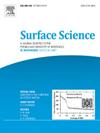Analyzing the capture of volatile polonium-210 in lead-bismuth eutectic coolant environments on metallic Pb, Pt, Au, and Cu (1 1 1) adsorption surfaces based on density functional theory
IF 1.8
4区 化学
Q3 CHEMISTRY, PHYSICAL
引用次数: 0
Abstract
This study uses density functional theory (DFT) to investigate the adsorption of volatile polonium species (Po, Po2, PbPo, H2Po, and PoOH) on Pd, Pt, Au, and Cu (1 1 1) surfaces, critical for capturing radioactive polonium in lead-bismuth eutectic (LBE) nuclear coolants. Geometric optimizations and adsorption energy calculations show Pd and Pt (1 1 1) surfaces exhibit superior adsorption for most species: monatomic Po adsorbs strongest on Pd (−3.95 eV) via covalent/orbital hybridization; Po2 and PbPo form stable dissociative/cooperative bonds on Pd/Pt; H2Po shows weak physisorption on Au/Cu due to limited orbital overlap; PoOH favors Pt through hydrogen bonding and O-M interactions. Electron density changes (Δρ(r)) and partial density of states (PDOS) confirm strong chemisorption with electron accumulation and orbital hybridization, aligning with frontier orbital theory predictions. Adsorption trends follows the order of Pd/Pt > Cu > Au and the adsorption reactivity of Po species on the Pd(1 1 1) surfaces occur most spontaneously within LBE coolant operation temperature highlight Pd as promising for filter materials, providing a theoretical basis for mitigating polonium volatility in advanced nuclear systems.

基于密度泛函理论分析铅铋共晶冷却剂环境中挥发性钋-210在金属Pb、Pt、Au和Cu(11 11)吸附表面的捕获
本研究利用密度泛函理论(DFT)研究了挥发性钋(Po, Po2, PbPo, H2Po和PoOH)在Pd, Pt, Au和Cu(11 11)表面的吸附,这对于捕获铅铋共晶(LBE)核冷却剂中的放射性钋至关重要。几何优化和吸附能计算表明,Pd和Pt(11 11)表面对大多数物质具有优越的吸附性能:单原子Po通过共价/轨道杂化对Pd (- 3.95 eV)的吸附最强;Po2和PbPo在Pd/Pt上形成稳定的解离/协同键;由于轨道重叠有限,H2Po对Au/Cu的物理吸附较弱;PoOH通过氢键和O-M相互作用有利于Pt。电子密度变化(Δρ(r))和部分态密度(PDOS)证实了电子积累和轨道杂化的强化学吸附,与前沿轨道理论预测一致。吸附趋势遵循Pd/Pt >的顺序;铜比;在LBE冷却剂工作温度下,Au和Po在Pd(11 11)表面的吸附反应性最自发地发生,突出了Pd作为过滤材料的前景,为减轻先进核系统中钋的挥发性提供了理论基础。
本文章由计算机程序翻译,如有差异,请以英文原文为准。
求助全文
约1分钟内获得全文
求助全文
来源期刊

Surface Science
化学-物理:凝聚态物理
CiteScore
3.30
自引率
5.30%
发文量
137
审稿时长
25 days
期刊介绍:
Surface Science is devoted to elucidating the fundamental aspects of chemistry and physics occurring at a wide range of surfaces and interfaces and to disseminating this knowledge fast. The journal welcomes a broad spectrum of topics, including but not limited to:
• model systems (e.g. in Ultra High Vacuum) under well-controlled reactive conditions
• nanoscale science and engineering, including manipulation of matter at the atomic/molecular scale and assembly phenomena
• reactivity of surfaces as related to various applied areas including heterogeneous catalysis, chemistry at electrified interfaces, and semiconductors functionalization
• phenomena at interfaces relevant to energy storage and conversion, and fuels production and utilization
• surface reactivity for environmental protection and pollution remediation
• interactions at surfaces of soft matter, including polymers and biomaterials.
Both experimental and theoretical work, including modeling, is within the scope of the journal. Work published in Surface Science reaches a wide readership, from chemistry and physics to biology and materials science and engineering, providing an excellent forum for cross-fertilization of ideas and broad dissemination of scientific discoveries.
 求助内容:
求助内容: 应助结果提醒方式:
应助结果提醒方式:


